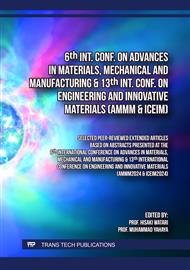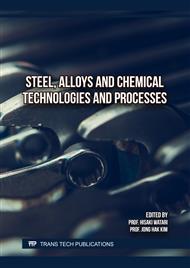p.25
p.31
p.37
p.43
p.51
p.57
p.65
p.73
p.79
Effect of Lamellae Modification in Eutectic Al82.70Cu17.30 Alloy on its Electrochemical Performance as Anode Using Symmetric Cell Electrochemical Impedance Spectroscopy
Abstract:
The purpose of this research is investigating the effect of eutectic lamellae modification through heat-treatments on the electrochemical performance of Eutectic aluminum-copper (E-Al82.70Cu17.30 at%) alloy. The alloy works as anode in less expensive aluminum chloride (AlCl3) aqueous electrolyte using Symmetric Cell Electrochemical Impedance Spectroscopy (SCEIS). The alloy was produced using an arc furnace followed by heat-treatments at different conditions. X-ray diffraction (XRD), optical microscope (OM), were used to characterize the alloys followed by SCEIS testing. The as-cast E-Al82.70Cu17.30 showed some inhomogeneities in the lamellae microstructure, while heat-treating the as-cast E-Al82.70Cu17.30 produced homogenized sponge-like eutectic microstructure. Two heat-treatment conditions were employed, that is 1. Heating the as cast alloy at 535 °C and soaking for one hour, and 2. Heating at 535 °C and soaking for five hours. Electrochemical Impedance spectroscopy measurements were performed on these three (3) samples. The Nyquist plot of as-cast E-Al82.70Cu17.30, 1 and 5 hours annealling heat-treated (1HT and 5HT respectively) displayed characteristic diameters in high, medium, and also low frequency range. After fitting using complex non-linear least squares method, 1HT condition has bulk resistance (RI) and charge transfer resistance (RCT) of ~9 Ω and ~566 Ω respectively, as compared to As-cast condition, which has RI of ~ 14 Ω and RCT of ~ 695 Ω, whiles 5HT condition has RI of ~26 Ω and RCT of ~724 Ω.
Info:
Periodical:
Pages:
51-56
Citation:
Online since:
June 2025
Price:
Сopyright:
© 2025 Trans Tech Publications Ltd. All Rights Reserved
Share:
Citation:



